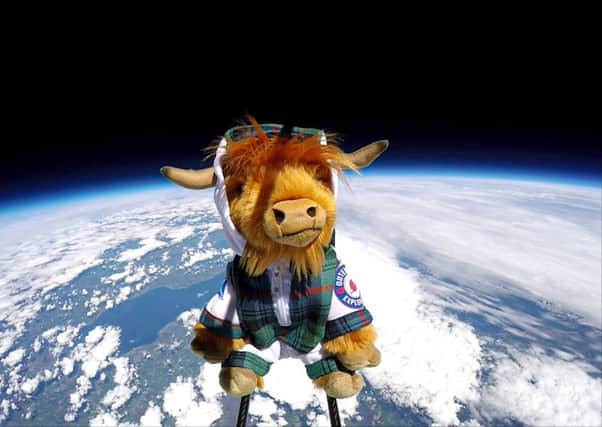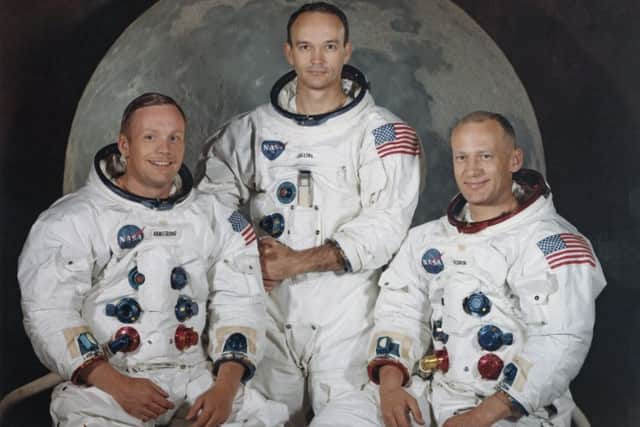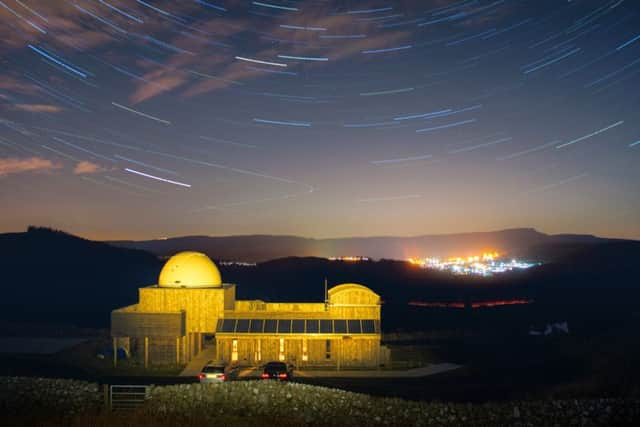Forget Neil and Buzz, meet Scotland’s coosmonaut BuzzBò!


But that’s old news – Scotland has its very own space hero to celebrate!
BuzzBò, the world’s first Highland Coosmonaut, soared 36,000 metres into near space recently, wearing an Armstrong tartan spacesuit.
Advertisement
Hide AdAdvertisement
Hide AdVisitScotland teamed up with Sent Into Space to send the cuddly toy into orbit.


Footage of him lifting off by weather balloon from Gilnockie Tower, the ancestral home of Clan Armstrong, and landing safely near Cranshaws in the Scottish Borders, was released on July 16, the date the Apollo 11 mission took flight – now also known as #Coosday.
BuzzBò was named by seven-year-old Peter Lunan, of Dunblane, following a national competition.
The name derives from Buzz Aldrin, the second man to walk on the Moon, and the Gaelic word for cow, Bò.
Advertisement
Hide AdAdvertisement
Hide AdAlex Keen, launch specialist from Sent into Space, said: “Launching at Gilnockie Tower was a real treat. Not only were the team from VisitScotland a great bunch to work with but the countryside we crossed in pursuit of our payload is one of the most beautiful and dramatic landscapes we’ve visited.


“Once the Coosmonaut was back in our hands, we were genuinely sad to leave and head back to England.”
A new tourism map highlighting Scotland’s links to space exploration and the first moonwalk has also been released.
The Scotland is Out of this World trail is part of the new VisitScotland campaign of the same name.
Advertisement
Hide AdAdvertisement
Hide AdThe trail features Scottish connections to each planet in the solar system, as well as fun facts and details of science centres and the best places to stargaze.
Highlights incude:
Mars – Glenelg, Highlands: In 2012 the village twinned with a geological feature on Mars, called Glenelg.
Jupiter – Loch Airigh, Isle of Harris: The loch in the Outer Hebrides portrays the planet Jupiter in the 1968 Stanley Kubrick directed film, 2001: A Space Odyssey.
Uranus – Braemar: The birthplace of Johann von Lamont, an astronomer who calculated the mass of Uranus.
Advertisement
Hide AdAdvertisement
Hide AdNeptune – Jedburgh, Scottish Borders: The birthplace of 19th century science writer Mary Somerville who theorised that difficulties in calculating the position of Uranus may point to an undiscovered planet, which inspired the discovery of Neptune.
Venus – Parton, Dumfries and Galloway: The resting place of 19th century physicist James Clerk Maxwell, whose name was given to Maxwell Montes, the planet’s only feature named after a man.
The Scotland is Out of this World campaign marks the 50th anniversary of the Apollo 11 mission and US astronaut Neil Armstrong’s historic walk on the lunar surface.
But it also celebrates the 50th anniversary of VisitScotland.
Advertisement
Hide AdAdvertisement
Hide AdMalcolm Roughead, chief executive, said: “For 50 years VisitScotland has helped position Scotland as a must-visit destination to audiences across the world.
“It is therefore fitting that in our anniversary year we set our sights even further and travelled into space in what can only be described as a truly out of this world campaign.
“Scotland is Out of this World offered the opportunity to delve into the past and celebrate the country’s contribution to space exploration and its ancestral links to one of the greatest moments in history.
“The new trail reveals some of the country’s stellar attractions and locations to visit to firmly cement Scotland’s place in astro-tourism.
Advertisement
Hide AdAdvertisement
Hide Ad“After all, our best views aren’t confined to our awe-inspiring landscapes but reach up high into the night sky above as well.”
Ohio-born Neil Armstrong was proud of his Scottish heritage. The ancestral home of Clan Armstrong is Langholm in Dumfries and Galloway and in 1972 he become the town’s first and only Freeman.
Travel guide publisher, Lonely Planet, has identified dark skies as a tourism trend for 2019.
VisitScotland’s Insight team has created a research paper examining the opportunities for tourism businesses to engage with the trend.
Advertisement
Hide AdAdvertisement
Hide AdScotland is home to two International Dark Sky Parks, Galloway Forest Park in Dumfries and Galloway and Tomintoul and Glenlivet in Cairngorms National Park. Isle of Coll is also a Dark Sky Island and Moffat a Dark Sky Town.
To view the map, visit static.visitscotland.com/pdf/out-of-this-world-trail.pdf.
First man on the moon’s Scottish links
Neil Armstrong, Buzz Aldrin and Michael Collins formed the three-man NASA mission which set off on July 16, 1969, to land on the surface of the Moon.
On the evening of July 20, Armstrong and Aldrin touched down on the lunar surface.
Advertisement
Hide AdAdvertisement
Hide AdArmstrong took “one giant leap for mankind” when he became the first person to walk on the moon.
Three years after that historic moment, the Ohio-born NASA astronaut who commanded Apollo 11 took another “small step” into the history books in Langholm, the ancestral home of Clan Armstrong.
There, in the “Muckle Toon”, he became the first and only person to be awarded the freedom of the burgh.
Accepting the honour, he told the audience: “It’s said that the most difficult place to be recognised is in one’s own home town. And I consider this, now, my home town.”
Advertisement
Hide AdAdvertisement
Hide AdMany craters on the Moon and Mars are named after Scottish scientists. They include Aberdeen astronomers Arthur Mee and Sir David Gill and Edinburgh mathematician John Napier of Merchiston.
The average distance from Earth to the Moon is about 238,855 miles (384,400 km).